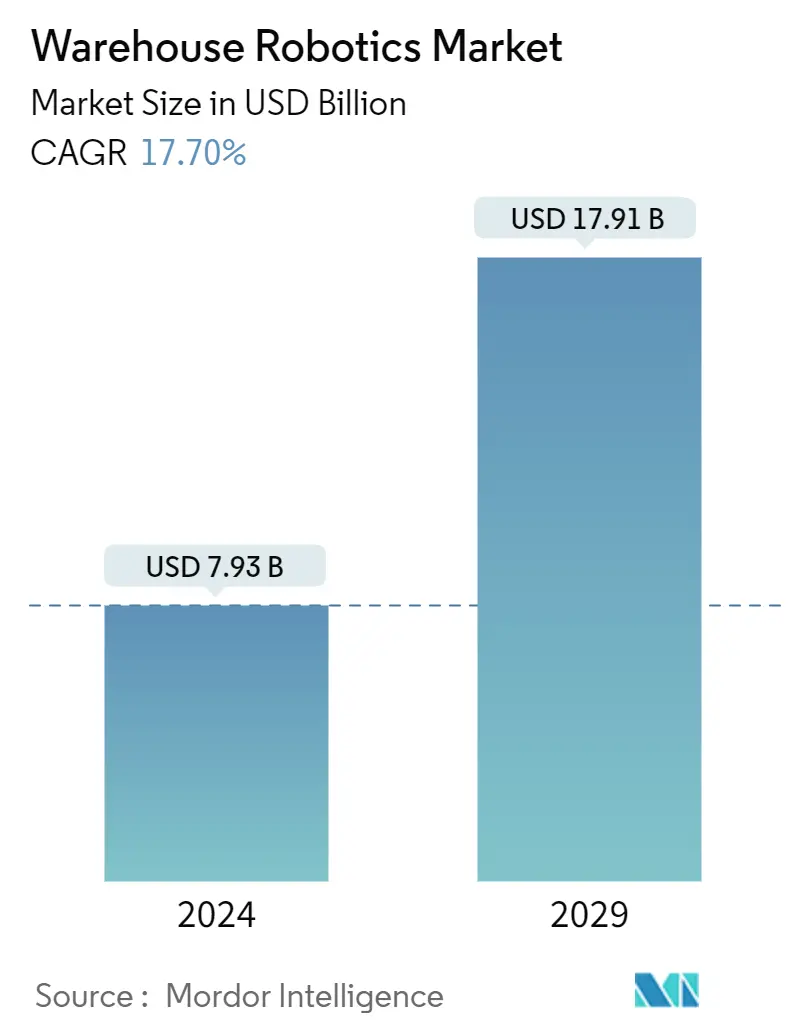Market Size of Warehouse Robotics Industry

| Study Period | 2019 - 2029 |
| Market Size (2024) | USD 7.93 Billion |
| Market Size (2029) | USD 17.91 Billion |
| CAGR (2024 - 2029) | 17.70 % |
| Fastest Growing Market | Asia Pacific |
| Largest Market | Asia Pacific |
Major Players
*Disclaimer: Major Players sorted in no particular order |
Need a report that reflects how COVID-19 has impacted this market and its growth?
Warehouse Robotics Market Analysis
The Warehouse Robotics Market size is estimated at USD 7.93 billion in 2024, and is expected to reach USD 17.91 billion by 2029, growing at a CAGR of 17.70% during the forecast period (2024-2029).
The emergence of the Industrial Internet of Things (IIoT) and the advent of a network of connected systems are helping industries perform a multitude of tasks, such as material batching, picking, ordering, packaging, warehouse security, and inspection, as well as improve the operational efficiency by huge margins.
- The growth in the e-commerce industry worldwide and the growing need for efficient warehousing and inventory management are driving the market's growth. Automation in warehousing offers extreme convenience in cutting down overall business costs and reducing errors in product deliveries.
- According to DHL, a prominent 3PL company and a significant end-user of warehouse automation solutions, despite the advantages, 80% of warehouses are 'still manually operated with no supporting automation.' Further, warehouses that use conveyors, sorters, and pick and place solutions, among other equipment (not necessarily automated), account for 15% of total warehouses. In contrast, only 5% of current warehouses are automatic.
- Significant technological advancements, such as sensor technologies that enable an enhanced object perception and an accurate positioning system, have made way for the robotics industry to explore the untapped potential in various warehousing applications while attaining an optimal operational flow and logistics efficiency, among other accomplishments, across the different industry verticals.
- According to the Bank of America, by 2025, 45% of all manufacturing tasks will be executed by robotic technology. With this emerging trend, large firms, such as Raymond Limited, a prominent Indian textile company, and Foxconn Technology, a China-based supplier for large technology manufacturers like Samsung, have replaced 10,000 and 60,000 workers, respectively, by incorporating automated technology into their factories.
- These factors have directly impacted the increasing adoption of warehouse robotics. The rising number of warehouses and increasing investments in warehouse automation, coupled with the global rise in labor costs and availability of scalable technological solutions, have been driving the market for warehouse robots worldwide. For instance, prominent logistics brands in the United States, like DHL, XPO Logistics, and NFI Logistics, are investing in expansion activities, despite the adverse commercial renting climate.
- During the COVID-19 outbreak, robots and automation played a critical role in managing the situation. Further, the situation is likely to bring new opportunities to the market. Ocado, a British online grocer, aims to make its warehouse robotics and grocery home-delivery technology available to other supermarkets for a licensing fee. Since May 2020, many warehouse sites have recovered after starting their operations post lockdown. However, the fluctuations caused in the starting four months of 2020 could result in order delays and lead time across the warehouse robotics supply chain throughout the year.
- While significant advances have been accomplished in robotics, the human workforce still holds the upper hand in running a well-organized warehouse. Forecast of long-term labor shortages across the United States and Europe and sustained pressure on supply chains to deliver orders quickly and more precisely caused operations executives to seriously assess that question as they look for answers to staffing challenges.
